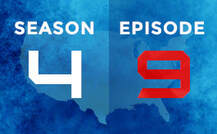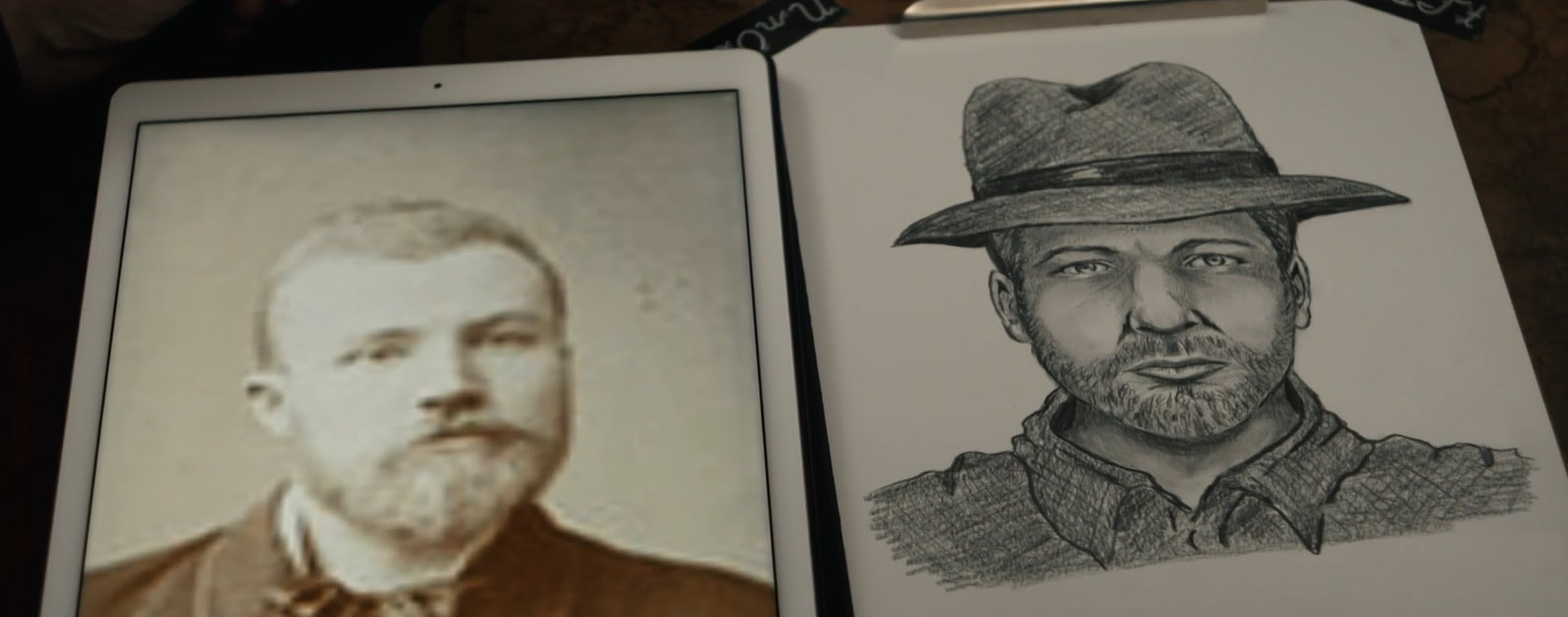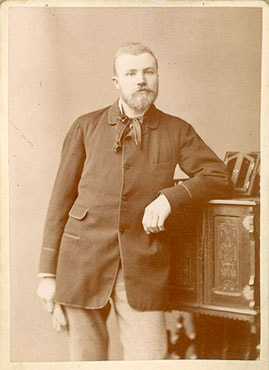On Tuesday, the new episode that aired reached just 474,000 viewers, a middling audience in a country of 320 million, but easily outpacing much splashier fare, including the JFK Jr. retrospective airing on A&E and Alternatino on Comedy Central. On the other hand, it lost 50,000 viewers from the Expedition Unknown rerun airing right before, suggesting that the Travel Channel audience agrees that America Unearthed is not what it used to be. Segment 1 We open with news footage of bombings of the past thirty years, including the Oklahoma City federal building attack of 1995 and the World Trade Center bombing of 1993. Wolter then claims that the first person ever to bomb on U.S. soil has finally been identified. We cut to the opening credits—whose discussion of “artifacts,” “inscriptions,” and “tombs” has never been less connected to the content of the show—and then we see footage of the Boston Marathon bombing of 2013. Wolter recall where he was on that fateful day… Duluth, Minn. The story is… not relevant. Wolter announces that he plans to investigate the May 4, 1886 Haymarket Massacre, which began with a bomb thrown during a labor protest and to find out who threw the bomb, a question that has remained unanswered for more than 130 years. We then watch a historical reenactment of the bombing and subsequent police gunfire, resulting in eight deaths. Wolter is in Chicago meeting with Bleue Benton, a researcher who wants his help to find a time capsule buried in 1892 beneath the Haymarket victims’ memorial with newspaper articles, photographs, and trial transcripts. (These transcripts are available from other sources, and they are not a secret.) Benton believes that Wolter’s geological expertise in stone and concrete can help him to identify the location of the time capsule. However, Wolter concludes that there is no way to excavate the time capsule due to the size and weight of the monument, which would be damaged by any dig. He vows to investigate anyway, and Benton tells Wolter about an alleged Pinkerton’s conspiracy to weaken labor on behalf of big business to make the labor movement look like a bunch of violent radicals. The conspiracy suggests that business paid the Pinkerton detectives to pose as anarchists and to bomb the Haymarket to turn public opinion against labor. Therefore, Wolter visits the Pinkertons, who tell Wolter that there is no definitive information. Wolter suggests that he could answer the question by studying the specs of the bomb to determine whether it was intended to be deadly or a distraction. Wolter meets with the FBI’s top explosive scientist, Kirk Yeager, and the two prepare a plan to recreate the bomb to measure its destructive power. Then we go to commercial, having wasted 15 minutes of air time on about three minutes of content. Segment 2 The second segment is all about making the bomb. The cooperation between the FBI and America Unearthed gives the lie to early seasons’ suggestions of a government conspiracy to suppress the truth and block Wolter’s investigations. Wolter visits the Chicago History Museum to see remaining evidence of the bombs that were made for the Haymarket attack, and we slowly go through the process of assembling a bomb in the nineteenth century style with the help of various experts, and we cut to commercial with Wolter promising to blow up the recreated bomb. I imagine that the show’s core audience of old men are very excited by this, but I tend to find watching people make things to be rather boring, particularly when the bottom line is a one-sentence summary of whether the bomb was intended to be powerful enough to cause injury or death or whether it was meant to be a glorified firecracker. I don’t need two and half segments of a TV show to get to that sentence. Segment 3 In Camp Ripley, Minn., a military and police training facility, Wolter arrives to blow up the test bomb with the help of the FBI. The show chooses to approach this in one of the most boring ways possible. Wolter tries to throw one of the test bombs (without explosives) to prove it could be hurled a long distance—to which, duh. Shotput is a sport. A live bomb is detonated amidst a field of mannequins, and Wolter concludes from the damage they sustained that the bomb was intended to kill and therefore was the work of an actual anarchist and not a Pinkerton pretending to be one, on the theory that the Pinkertons wouldn’t have intentionally tried to kill cops. We go to commercial, having now spent more than half of the show on ideas that might reasonably have filled five to seven minutes of screen time in a better-written documentary. Segment 4 The segment opens with a glamor shot of Wolter’s Masonic double-eagle pinkie ring as he reads papers and begins to speculate about whether German immigrant George Meng was the Haymarket bomber. His great-granddaughter tells Wolter that her mother thought Meng to be the bomber (a claim circulating since the 1980s), but there is no clear evidence that Meng was in the right place at the right time. Wolter goes over the evidence in his lab with Yeager, and we see Masonic symbols and paraphernalia on the walls. The two review a number of potential suspects and focus in on Rudolph Schnaubelt, a leading anarchist and associate of Meng. Some sleight of hand conceals from viewers that Schnaubelt was the suspect that Chicago police had identified at the time of the attack and whom a witness identified as the bomber. A police captain became incensed at the “stupidity” of the officers who let him go after arresting him twice. We cut to commercial with Wolter promising to learn more. Segment 5 Man, this episode is dragging due to the lack of facts and content. Restating the same thing over and over again makes the time pass very slowly, no matter how much dramatic music gets thrown over the lack of content. Local Chicago historian Richard Lindberg discusses various claims with Wolter, but it’s mostly just a reprise of information from earlier segments. Wolter says that Lindberg’s information “seals the deal” because Schnaubelt moved to California and died there in 1896. I’m not entirely certain how, but Lindberg suggests that Schnaubelt was “on the run.” Well, we already knew he was a wanted anarchist, so I’m not sure how this adds additional evidence for his guilt. It seems that some key information was missing from the segment, such as the fact that Schnaubelt was long considered the chief suspect, apparently to make the Schnaubelt revelation seem more dramatic. Everything Lindberg tells Wolter has been known for nearly a century. For example, Art Young described the same thing—right down to the claim that Schnaubelt’s move to California was a flight from justice--in 1939. Wolter visits police sketch artist Luis Santoyo at the Cook County Sheriff’s Office to have the artist create a sketch of the Haymarket bomber based on eyewitness descriptions of the bomber. Wolter hopes that the resulting sketch will match a photograph of Schnaubelt, and we cut to commercial before finding out. Segment 6 In the final segment, Wolter and Santoyo decide that the resulting sketch looks similar to Schnaubelt, though really it could be almost any Victorian white guy. The show uses a strange angle to enhance the similarity and obscure differences. Seen straight on, Schnaubelt appears rounder and softer than the hard-angled sketch. Wolter calls the resemblance uncanny, but we don’t get important information, like whether Santoyo was already familiar with Schnaubelt’s photo, as seems likely given that Schnaubelt was the police’s chief suspect in 1886 and has been frequently identified as the bomber since then. This could have influenced his depiction. At this point the Travel Channel app broke down and spiraled into an endless cycle of commercials, and I wasn’t sure I wanted to spend the time trying to see the last three minutes of the show. I powered through anyway, only to be rewarded with Wolter restating everything we saw in the earlier segments as he tells Benton that Schnaubelt was the most likely bomber. Wolter summarizes with paean to the labor movement and his support for a higher minimum wage.
9 Comments
Jim
7/17/2019 06:57:21 pm
Wolter in his dumb bomb test assumes all dynamite has the same power, it doesn't, the strength is dependent upon the percentage of nitro glycerin in the formula.
Reply
TONY S.
7/17/2019 09:02:20 pm
There are plenty of more interesting and authentic Victorian era mysteries which occurred in the US that Wolter could have examined, if he or the people at AU actually had a clue about history.
Reply
Paul
7/18/2019 10:16:42 am
Would hope that AU and Wolter reimbursed taxpayers for any costs associated with police, fbi, etc. Wasting taxpayer money on Wolter's bullshit is disgusting.
Reply
TONY S.
7/18/2019 10:30:35 am
Agreed. "Disgusting" is the perfect word.
Reply
Jim
7/18/2019 11:32:39 am
I agree as well, unless the FBI is completely incompetent they had to know that the whole thing was nothing more than (not so) cheap theatrics that had no real purpose whatsoever.
Reply
Accumulated Wisdom, Ex-fbi agent
7/18/2019 12:30:03 pm
My contacts at the Bureau have informed me that it was decided that the positive publicity associated with the FBI’s involvement with the program was considered sufficient reimbursement for the expenditure of taxpayer financed resources.
Kent
7/24/2019 12:03:04 am
I would like to know if Wolter or the producers paid the appropriate fee to the BATFE (Batmen) for construction of a Destructive Device.
Reply
Accumulated Wisdom
7/18/2019 01:08:02 pm
"I imagine that the show’s core audience of old men are very excited by this..."
Reply
William Smith
7/21/2019 10:31:11 am
The FBI established in 1908 long after the bombing 22 years before is a good example of how our tax money is wasted. I do hope they spend time and money on more current items with more credible facts than making second rate TV shows.
Reply
Your comment will be posted after it is approved.
Leave a Reply. |
AuthorI am an author and researcher focusing on pop culture, science, and history. Bylines: New Republic, Esquire, Slate, etc. There's more about me in the About Jason tab. Newsletters
Enter your email below to subscribe to my newsletter for updates on my latest projects, blog posts, and activities, and subscribe to Culture & Curiosities, my Substack newsletter.
Categories
All
Terms & ConditionsPlease read all applicable terms and conditions before posting a comment on this blog. Posting a comment constitutes your agreement to abide by the terms and conditions linked herein.
Archives
July 2024
|
- Home
- Blog
- Books
-
Articles
-
Newsletter
>
- Television Reviews >
- Book Reviews
- Galleries >
- Videos
-
Collection: Ancient Alien Fraud
>
- Chariots of the Gods at 50
- Secret History of Ancient Astronauts
- Of Atlantis and Aliens
- Aliens and Ancient Texts
- Profiles in Ancient Astronautics >
- Blunders in the Sky
- The Case of the False Quotes
- Alternative Authors' Quote Fraud
- David Childress & the Aliens
- Faking Ancient Art in Uzbekistan
- Intimations of Persecution
- Zecharia Sitchin's World
- Jesus' Alien Ancestors?
- Extraterrestrial Evolution?
- Collection: Skeptic Magazine >
- Collection: Ancient History >
- Collection: The Lovecraft Legacy >
- Collection: UFOs >
- Scholomance: The Devil's School
- Prehistory of Chupacabra
- The Templars, the Holy Grail, & Henry Sinclair
- Magicians of the Gods Review
- The Curse of the Pharaohs
- The Antediluvian Pyramid Myth
- Whitewashing American Prehistory
- James Dean's Cursed Porsche
-
Newsletter
>
-
The Library
-
Ancient Mysteries
>
-
Ancient Texts
>
- Mesopotamian Texts >
-
Egyptian Texts
>
- The Shipwrecked Sailor
- Dream Stela of Thutmose IV
- The Papyrus of Ani
- Classical Accounts of the Pyramids
- Inventory Stela
- Manetho
- Eratosthenes' King List
- The Story of Setna
- Leon of Pella
- Diodorus on Egyptian History
- On Isis and Osiris
- Famine Stela
- Old Egyptian Chronicle
- The Book of Sothis
- Horapollo
- Al-Maqrizi's King List
- Teshub and the Dragon
- Hermetica >
- Hesiod's Theogony
- Periplus of Hanno
- Ctesias' Indica
- Sanchuniathon
- Sima Qian
- Syncellus's Enoch Fragments
- The Book of Enoch
- Slavonic Enoch
- Sepher Yetzirah
- Tacitus' Germania
- De Dea Syria
- Aelian's Various Histories
- Julius Africanus' Chronography
- Eusebius' Chronicle
- Chinese Accounts of Rome
- Ancient Chinese Automaton
- The Orphic Argonautica
- Fragments of Panodorus
- Annianus on the Watchers
- The Watchers and Antediluvian Wisdom
-
Medieval Texts
>
- Medieval Legends of Ancient Egypt >
- The Hunt for Noah's Ark
- Isidore of Seville
- Book of Liang: Fusang
- Agobard on Magonia
- Book of Thousands
- Voyage of Saint Brendan
- Power of Art and of Nature
- Travels of Sir John Mandeville
- Yazidi Revelation and Black Book
- Al-Biruni on the Great Flood
- Voyage of the Zeno Brothers
- The Kensington Runestone (Hoax)
- Islamic Discovery of America
- The Aztec Creation Myth
-
Lost Civilizations
>
-
Atlantis
>
- Plato's Atlantis Dialogues >
- Fragments on Atlantis
- Panchaea: The Other Atlantis
- Eumalos on Atlantis (Hoax)
- Gómara on Atlantis
- Sardinia and Atlantis
- Santorini and Atlantis
- The Mound Builders and Atlantis
- Donnelly's Atlantis
- Atlantis in Morocco
- Atlantis and the Sea Peoples
- W. Scott-Elliot >
- The Lost Atlantis
- Atlantis in Africa
- How I Found Atlantis (Hoax)
- Termier on Atlantis
- The Critias and Minoan Crete
- Rebuttal to Termier
- Further Responses to Termier
- Flinders Petrie on Atlantis
- Amazing New Light (Hoax)
- Lost Cities >
- OOPARTs
- Oronteus Finaeus Antarctica Map
- Caucasians in Panama
- Jefferson's Excavation
- Fictitious Discoveries in America
- Against Diffusionism
- Tunnels Under Peru
- The Parahyba Inscription (Hoax)
- Mound Builders
- Gunung Padang
- Tales of Enchanted Islands
- The 1907 Ancient World Map Hoax
- The 1909 Grand Canyon Hoax
- The Interglacial Period
- Solving Oak Island
-
Atlantis
>
- Religious Conspiracies >
-
Giants in the Earth
>
-
Fossil Origins of Myths
>
- Fossil Teeth and Bones of Elephants
- Fossil Elephants
- Fossil Bones of Teutobochus
- Fossil Mammoths and Giants
- Giants' Bones Dug Out of the Earth
- Fossils and the Supernatural
- Fossils, Myth, and Pseudo-History
- Man During the Stone Age
- Fossil Bones and Giants
- Mastodon, Mammoth, and Man
- American Elephant Myths
- The Mammoth and the Flood
- Fossils and Myth
- Fossil Origin of the Cyclops
- History of Paleontology
- Fragments on Giants
- Manichaean Book of Giants
- Geoffrey on British Giants
- Alfonso X's Hermetic History of Giants
- Boccaccio and the Fossil 'Giant'
- Book of Howth
- Purchas His Pilgrimage
- Edmond Temple's 1827 Giant Investigation
- The Giants of Sardinia
- Giants and the Sons of God
- The Magnetism of Evil
- Tertiary Giants
- Smithsonian Giant Reports
- Early American Giants
- The Giant of Coahuila
- Jewish Encyclopedia on Giants
- Index of Giants
- Newspaper Accounts of Giants
- Lanier's A Book of Giants
-
Fossil Origins of Myths
>
-
Science and History
>
- Halley on Noah's Comet
- The Newport Tower
- Iron: The Stone from Heaven
- Ararat and the Ark
- Pyramid Facts and Fancies
- Argonauts before Homer
- The Deluge
- Crown Prince Rudolf on the Pyramids
- Old Mythology in New Apparel
- Blavatsky on Dinosaurs
- Teddy Roosevelt on Bigfoot
- Devil Worship in France
- Maspero's Review of Akhbar al-zaman
- The Holy Grail as Lucifer's Crown Jewel
- The Mutinous Sea
- The Rock Wall of Rockwall
- Fabulous Zoology
- The Origins of Talos
- Mexican Mythology
- Chinese Pyramids
- Maqrizi's Names of the Pharaohs
-
Extreme History
>
- Roman Empire Hoax
- American Antiquities
- American Cataclysms
- England, the Remnant of Judah
- Historical Chronology of the Mexicans
- Maspero on the Predynastic Sphinx
- Vestiges of the Mayas
- Ragnarok: The Age of Fire and Gravel
- Origins of the Egyptian People
- The Secret Doctrine >
- Phoenicians in America
- The Electric Ark
- Traces of European Influence
- Prince Henry Sinclair
- Pyramid Prophecies
- Templars of Ancient Mexico
- Chronology and the "Riddle of the Sphinx"
- The Faith of Ancient Egypt
- Remarkable Discoveries Within the Sphinx (Hoax)
- Spirit of the Hour in Archaeology
- Book of the Damned
- Great Pyramid As Noah's Ark
- Richard Shaver's Proofs
-
Ancient Texts
>
-
Alien Encounters
>
-
US Government Ancient Astronaut Files
>
- Fortean Society and Columbus
- Inquiry into Shaver and Palmer
- The Skyfort Document
- Whirling Wheels
- Denver Ancient Astronaut Lecture
- Soviet Search for Lemuria
- Visitors from Outer Space
- Unidentified Flying Objects (Abstract)
- "Flying Saucers"? They're a Myth
- UFO Hypothesis Survival Questions
- Air Force Academy UFO Textbook
- The Condon Report on Ancient Astronauts
- Atlantis Discovery Telegrams
- Ancient Astronaut Society Telegram
- Noah's Ark Cables
- The Von Daniken Letter
- CIA Psychic Probe of Ancient Mars
- Scott Wolter Lawsuit
- UFOs in Ancient China
- CIA Report on Noah's Ark
- CIA Noah's Ark Memos
- Congressional Ancient Aliens Testimony
- Ancient Astronaut and Nibiru Email
- Congressional Ancient Mars Hearing
- House UFO Hearing
- Ancient Extraterrestrials >
- A Message from Mars
- Saucer Mystery Solved?
- Orville Wright on UFOs
- Interdimensional Flying Saucers
- Poltergeist UFOs
- Flying Saucers Are Real
- Report on UFOs
-
US Government Ancient Astronaut Files
>
-
The Supernatural
>
- The Devils of Loudun
- Sublime and Beautiful
- Voltaire on Vampires
- Demonology and Witchcraft
- Thaumaturgia
- Bulgarian Vampires
- Religion and Evolution
- Transylvanian Superstitions
- Defining a Zombie
- Dread of the Supernatural
- Vampires
- Werewolves and Vampires and Ghouls
- Science and Fairy Stories
- The Cursed Car
-
Classic Fiction
>
- Lucian's True History
- Some Words with a Mummy
- The Coming Race
- King Solomon's Mines
- An Inhabitant of Carcosa
- The Xipéhuz
- Lot No. 249
- The Novel of the Black Seal
- The Island of Doctor Moreau
- Pharaoh's Curse
- Edison's Conquest of Mars
- The Lost Continent
- Count Magnus
- The Mysterious Stranger
- The Wendigo
- Sredni Vashtar
- The Lost World
- The Red One
- H. P. Lovecraft >
- The Skeptical Poltergeist
- The Corpse on the Grating
- The Second Satellite
- Queen of the Black Coast
- A Martian Odyssey
- Classic Genre Movies
-
Miscellaneous Documents
>
- The Balloon-Hoax
- A Problem in Greek Ethics
- The Migration of Symbols
- The Gospel of Intensity
- De Profundis
- The Life and Death of Crown Prince Rudolf
- The Bathtub Hoax
- Crown Prince Rudolf's Letters
- Position of Viking Women
- Employment of Homosexuals
- James Dean's Scrapbook
- James Dean's Love Letters
- The Amazing James Dean Hoax!
- James Dean, The Human Ashtray
- Free Classic Pseudohistory eBooks
-
Ancient Mysteries
>
- About Jason
- Search
© 2010-2024 Jason Colavito. All rights reserved.








 RSS Feed
RSS Feed
